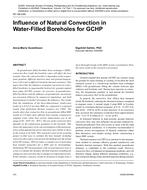Description
In groundwater filled borehole heat exchangers (BHE), convective flow inside the borehole water will affect the heat transfer. Since the convective flow is dependent of the temperature gradient, different injection rates and ground temperatures will result in different borehole thermal resistance. This paper describes the influence of natural convection in waterfilled boreholes in impermeable bedrock for ground-coupled heat pump (GCHP) systems. An overview of groundwaterfilled boreholes and the influence of groundwater movements are presented followed by numerical simulations and field measurements to further investigate the influence. The results from the simulations of the three-dimensional, steady-state model of a 9.8 ft (3 m) deep BHE are compared to evaluated results from performed thermal response test (TRT). The results show that convective flow in groundwater-filled BHE results in 5-9 times more efficient heat transfer compared to stagnant water when heat carrier temperatures are in the range of 50 – 86ºF (10 – 30ºC). The size of the convective flow depends on the temperature gradients in the borehole. This shows the importance of on-site investigation of thermal properties using appropriate power injection rates similar to those in the system to be built. This research is part of an on-going project to find ways to estimate the heat transfer including convective flow and to incorporate the findings into the design of GCHP systems. TRT are today a common way to determine heat transfer properties for a BHE and its surroundings. Performing TRT measurements with several injection rates is a way to evaluate the dynamic thermal response including the change in convective flow due to changes in temperature levels. If this dynamic response would be included in design tools a more thorough design of the BHE system is performed. Here, the early result of this research is presented.
Units: Dual
Citation: ASHRAE Transactions, vol. 114, pt. 1, New York 2008
Product Details
- Published:
- 2008
- Number of Pages:
- 8
- File Size:
- 1 file , 1.2 MB
- Product Code(s):
- D-NY-08-049




